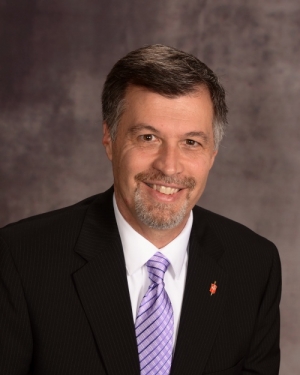news article
Bishop Webb on itinerancy
October 23, 2018 / By Upper New York Area Resident Bishop Mark J. Webb
Editor's Note: This article was originally published in The Fall 2018 (2018, issue 4) of teh Upper New York Advocate, which focused on intinerancy in the United Methodist Church.
The United Methodist system of itinerant ministry is rooted in John Wesley’s vision of spreading scriptural holiness across the land and utilizing both clergy and laity in the fulfillment of this mission. In the days of Francis Asbury, the first of two Methodist Bishops in the United States, a pastor – most often a circuit rider – might be appointed to half of a state or more.
“Itinerancy” refers specifically to the commitment by pastors to go and serve wherever their Bishop sends them. Early in the process of candidacy for pastoral ministry, United Methodist pastors are asked to reflect on the implications of itinerant ministry for their lives and families. No pastor is licensed for ministry without an agreement to serve where the resident Bishop appoints. Appointments are for one year at a time.
The Book of Discipline gives the responsibility for appointment-making to the Bishop and District Superintendents of the Annual Conference.
The Cabinet of the Upper New York Annual Conference begins each appointment-making season with an intensive three-day retreat in December, attempting to look at the big picture, establishing our purpose/goals for appointment making, and identifying what will be different because of our appointment work.
At the foundation of the appointment-making task is clarity regarding priorities for deploying clergy leadership. As we move through each appointment season, we have established the following priorities that guide our discussions, discernment and decisions.
- Prayer and God’s Agenda – This entire process is bathed in prayer seeking God’s desire for our life together as brothers and sisters in Christ and the ministry of congregations in the Upper New York Annual Conference.
- The Mission Field – What are the needs of the community surrounding the local congregation and how can we better equip the local church to engage the community in ministry?
- The Local Church – What is the current reality of this congregation? What strengths for ministry do they currently demonstrate and what are the areas of ministry that need to be developed? What kind of pastoral leadership will assist the congregation to fruitfully and effectively live the mission of making disciples of Jesus Christ for the transformation of the world in the days ahead? Who is God calling to be the next pastor?
- The Pastor – What are the gifts the pastor brings? How will this pastor help this congregation continue living the mission and move to the next level in their ministry to the community? How does this potential appointment fit within the personal needs/desires of the pastor?
These priorities help us to stay focused on the main thing, which is the mission of the Church and equipping the Church to more effectively and fruitfully live that mission. These priorities remind us that appointment-making must be responsive and not reactive, as the Church continues to seek transformation and vitality.
When we begin making appointments we consider full-time appointments first, then work on less than full-time appointments. As a potential appointment is discussed by the Cabinet, we begin with the understandings and needs shared through the consultation process. A common question is, “What are the gifts needed in the next pastor to assist this congregation for the future?” After conversation, the Cabinet enters into a time of prayer.
At the end of that prayer time, names of pastors that the Holy Spirit has brought to our minds and hearts are shared and added to a list of potential pastors for that specific congregation. Each person is then discussed asking two primary questions – “Why would this pastor fit here?” and “Why wouldn’t this pastor work here?” After another time of prayer, potential designations are made and then the Cabinet leaves the discussion of that congregation.
At the end of the Cabinet meeting, we revisit those potential designations and a final prayerful discernment is made or we acknowledge that we do not yet have the right person and commit to returning to the conversation at the next Cabinet meeting. Once a designation has been made, the discernment process continues by engaging the designated pastor and Staff/Pastor-Parish Relations Committee in conversation to assure the sense of God’s call. Finally, the Cabinet seeks to provide ongoing support for both churches and pastors when new appointments are made.
One of the challenges we must continue to wrestle with is that United Methodist pastors are itinerant in a time where the practice and reality of itinerancy is being tested and examined in new ways. Our commitment as a Cabinet is to honor our call as United Methodists to be fully itinerant, yet also be willing to engage in conversation that provides space regarding the realities of the 21st century.
The reality is that our appointment-making process is never perfect. We acknowledge that 14 humans are involved and while we deeply desire to seek God’s will, there are times that we do not get it right. However, even in spite of the human involvement, the great truth we celebrate is how often God indeed works in, through and in spite of the process and effective ministry and mission continue and begin among congregations and pastors. To that we say, “To God be the Glory.”
This issue of the Advocate contains true stories and resources that showcase how appointment making helps increase the capacity of every clergy person appointed in The Upper New York Conference. I hope that you will read each page and recognize the many opportunities for us to work together in providing healthy, effective, and fruitful partnerships of clergy and laity in every local congregation living the mission of “making disciples of Jesus Christ for the transformation of the world.”